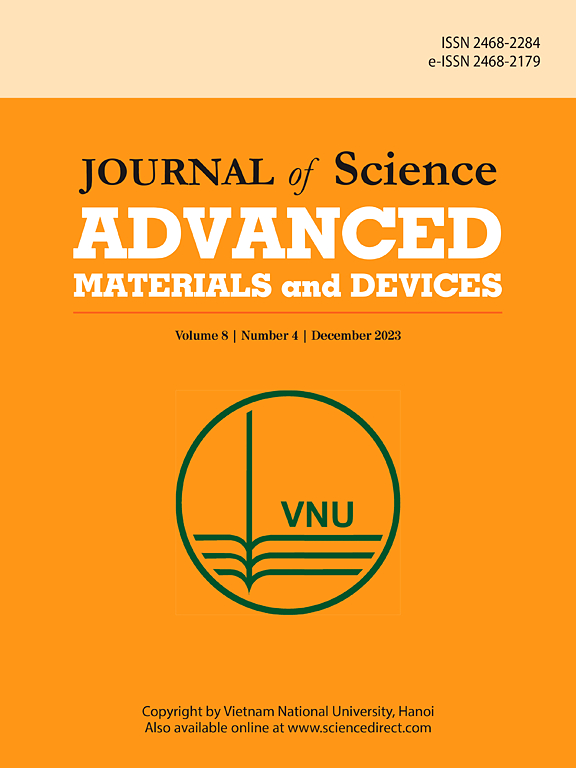Temperature-dependent properties of Cu-doped ZnTe thin films deposited on ultra-thin glass substrates via RF magnetron sputtering
IF 6.7
3区 材料科学
Q1 MATERIALS SCIENCE, MULTIDISCIPLINARY
Journal of Science: Advanced Materials and Devices
Pub Date : 2024-12-24
DOI:10.1016/j.jsamd.2024.100836
引用次数: 0
Abstract
This study investigates the viability of Cu-doped ZnTe as a potential back surface field (BSF) layer on flexible CdTe thin-film solar cells, examining its structural, morphological, optical, and electrical properties. ZnTe, 5%, and 8% Cu-doped ZnTe were deposited on ultra-thin glass (UTG) substrates using the radio frequency (RF) magnetron sputtering approach at varying substrate temperatures from room temperature to 300 °C. The finding reveals that the surface morphology significantly changes as the substrate temperature increases. Besides, incorporating Cu into ZnTe resulted in a denser and rougher surface, likely due to material densification and accelerated grain growth at higher temperatures. X-ray diffraction (XRD) analysis indicated that the crystallite size of the ZnTe and Cu-doped ZnTe increased with higher temperatures. Optical spectroscopy results demonstrated an increase in the optical band gap of ZnTe with increasing substrate temperature, while Cu-doping introduced a significant variability in the bandgap, particularly at different doping levels. In terms of electrical properties, ZnTe thin films exhibited carrier concentrations around 1014 cm−3. Conversely, the introduction of 5% and 8% Cu into ZnTe increased carrier concentrations, ranging from 1017 to 1020 cm−3, respectively, depending on substrate temperature and the amount of Cu concentration. Introducing Cu in the ZnTe structure may modify the characteristics of ZnTe thin films, potentially influencing its suitability as a BSF layer in CdTe solar cells by affecting its structural, optical, and electrical properties.

超薄玻璃基板上射频磁控溅射镀cu掺杂ZnTe薄膜的温度依赖特性
本研究探讨了cu掺杂ZnTe作为柔性CdTe薄膜太阳能电池的潜在背表面场(BSF)层的可行性,考察了其结构、形态、光学和电学性能。在室温至300℃的不同衬底温度下,采用射频磁控溅射方法将ZnTe、5%和8% cu掺杂的ZnTe沉积在超薄玻璃(UTG)衬底上。结果表明,随着衬底温度的升高,表面形貌发生了显著变化。此外,将Cu加入到ZnTe中会导致表面更致密和粗糙,这可能是由于材料致密化和高温下加速晶粒生长所致。x射线衍射(XRD)分析表明,随着温度的升高,ZnTe和cu掺杂ZnTe的晶粒尺寸增大。光谱学结果表明,随着衬底温度的升高,ZnTe的光学带隙增加,而cu掺杂导致了带隙的显著变化,特别是在不同掺杂水平下。电学性能方面,ZnTe薄膜载流子浓度约为1014 cm−3。相反,在ZnTe中引入5%和8%的Cu会增加载流子浓度,根据衬底温度和Cu浓度的不同,载流子浓度分别从1017到1020 cm−3不等。在ZnTe结构中引入Cu可能会改变ZnTe薄膜的特性,通过影响其结构、光学和电学性能,潜在地影响其作为CdTe太阳能电池中BSF层的适用性。
本文章由计算机程序翻译,如有差异,请以英文原文为准。
求助全文
约1分钟内获得全文
求助全文
来源期刊

Journal of Science: Advanced Materials and Devices
Materials Science-Electronic, Optical and Magnetic Materials
CiteScore
11.90
自引率
2.50%
发文量
88
审稿时长
47 days
期刊介绍:
In 1985, the Journal of Science was founded as a platform for publishing national and international research papers across various disciplines, including natural sciences, technology, social sciences, and humanities. Over the years, the journal has experienced remarkable growth in terms of quality, size, and scope. Today, it encompasses a diverse range of publications dedicated to academic research.
Considering the rapid expansion of materials science, we are pleased to introduce the Journal of Science: Advanced Materials and Devices. This new addition to our journal series offers researchers an exciting opportunity to publish their work on all aspects of materials science and technology within the esteemed Journal of Science.
With this development, we aim to revolutionize the way research in materials science is expressed and organized, further strengthening our commitment to promoting outstanding research across various scientific and technological fields.
 求助内容:
求助内容: 应助结果提醒方式:
应助结果提醒方式:


